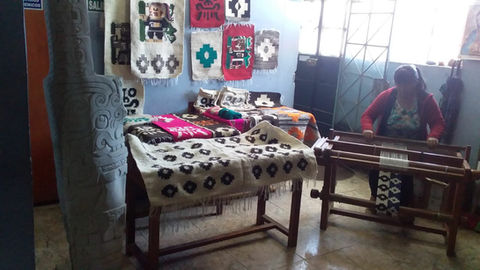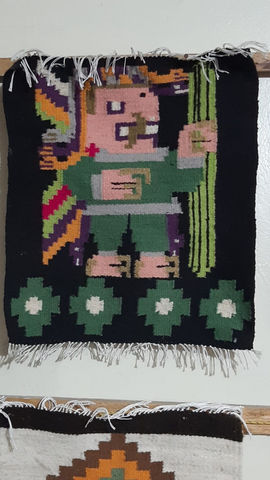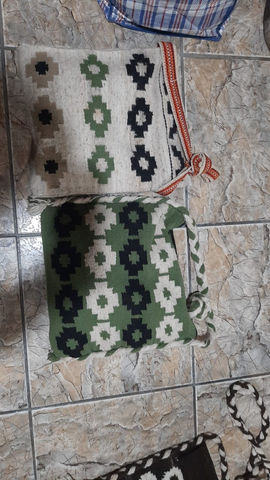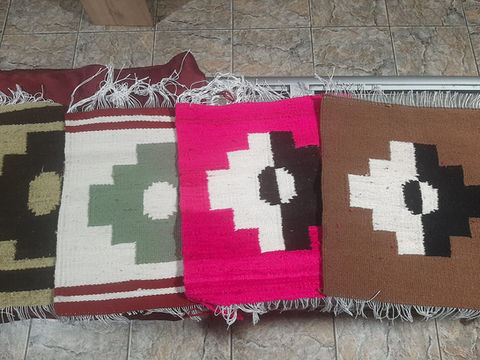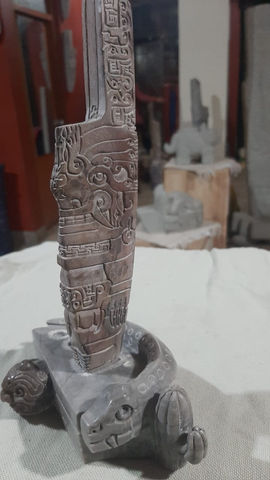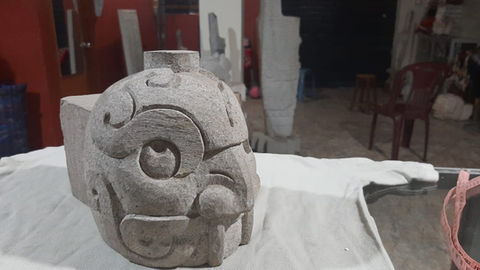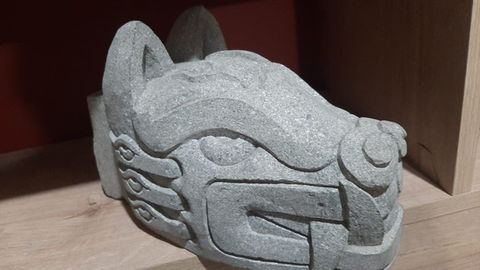It would be an enormous effort to explain the significance of the Chavin culture in a short essay, a culture that is considered to be a cradle of the Andean Civilization and a source of Huachuma tradition in Peru.
For the first time I’ve heard about it, was from my teacher and a brother in spirit, Don Howard, R.I.P., with whom I was working for three years before I (I’ve) moved to Peru in April of 2009 to serve Huachuma medicine.
My shamanic path began with him in 2005, on the Amazon near Iquitos. I’ve described this in detail in my first book PATH: Seeking Truth in a World of Lies, published in 2013.
Over the years, we’ve traveled together to ancient sites, a.k.a ‘’huacas’’ in Peru. One of them was Chavin de Huantar, an ancient temple located within two hours drive from Huaraz, Ancash, Peru. Through him, I met Martin, who is a native to Chavin. Martin’s story is pretty unique. Apparently, he grew up in the Chavin temple, literally, while living in a small wooden hut which was built for the guard by the cultural authorities to watch over the excavation of the temple. The ancient shamanic sanctuary was his playground. Martin felt a passion for stones early on and had made his first carving at the age of 8. Since then, for 40 years he kept working on stones embedding the ancient images engraved in Chavin temple onto them. Thus providing an opportunity for travelers to own a piece of an ancient culture in their homes.
Martin was the first native who welcomed me into Huachuma tradition, and together with him we cooked the medicine while visiting his home in 2008. This story is also shared in the book. Martin’s wife Gudelia Obregón Minaya also takes part in the family business. She is responsible for weaving the textiles, something she has done for the last 20 years. You can see her at work in the following pictures. A meticulous process of weaving takes lots of effort and time. For example, to weave a Huachumero manta it takes her a full month of daily work. She uses sheep’s wool and natural colors made from minerals and plants for dyeing the wool. Both Martin and Gudelia put their hearts into their hand made art.
The thought to help their work to be known to a wider audience came during one of the Huachuma ceremonies, when I was reflecting on our time spent together at Chavin.



Undoubtfully, the heart of the Chavin culture is the archaeological site of Chavín de Huantar. Began 3400 years ago, Chavín de Huantar become an important religious and political center and a pilgrim destination where people arrived from far to receive the blessings of Huachuma medicine. The site includes a complex of temples, plazas, and other architectural features that were constructed over a period of several centuries. Archeologists believe that the culture has flourished between 1400 BCE to 200 BCE. Perhaps this was the birthday of the Chavin culture which has been marked by an elaborate and complex monumental construction, however, the Huachuma tradition may have been around even longer and goes farther back into prehistoric times. I dive deeper in this subject in the book mentioned above, for those who are interested in ancient enigmas.
The Chavin culture is known for its distinctive art style, architecture, and religious practices. The Chavin people built large stone structures and monuments, many of which were decorated with carvings and sculptures. They also created a complex system of religious beliefs that centered around three main deities, two of which are depicted as an anthropomorphic figure holding huachuma cactus in their hands.

At the heart of Chavin religious beliefs was the worship of a deity which in the Qechua language is called the Tata Huanca, which means the Father figure. Archeologists gave it another name and it is now known as "Lanzón", or a Blade, a name that in their opinion best reflects this fine piece of ancient art.
The Lanzón Monolith is one of the most important and iconic artifacts from the Chavín de Huantar temple complex. The monolith is a large stone sculpture that measures approximately 4.5 meters (15 feet) in height, weighs over 3 tons, and it is carved with a complex and highly detailed design. This is the principal diety of Chavin culture and the central deity who was believed to be a superrnatural being who could control the natural world and the forces of the universe.
The Chavin religion also included the worship of other deities and spirits, such as the Jaguar, the Serpent and the Condor. Each of these spirits were associated with specific natural phenomena, such as water, earth and air, and also represent three worlds in the Andean cosmology:
Hanan Pacha: The upper world, the world of Spirit and Cosmos, represented by a Condor.
Kay Pacha: The world above the surface, where we exist in our bodies. Represented by a Puma.
Ukhu Pacha: Urin Pacha or the lower world, a world of the ancestors. Represented by a serpent.



It is located in the center of the Old Temple, which is the oldest part of the Chavín de Huantar complex. The monolith is housed in a chamber that is known as the Lanzón Gallery, located deep within the temple and can only be reached by a narrow labyrinth.
The Lanzón Monolith is considered to be one of the most important examples of Chavin art and iconography, and it is thought to have played a central role in the religious rituals and ceremonies that took place at the Chavín de Huantar temple complex. Perhaps, in the ancient times, the initiates after spending some time in (a) complete darkness of the underground labyrinths, were eventually led to meet the Lanzon which were lit by fire torches. Today, the monolith is still on display in the Lanzón Gallery, where visitors can see it in its original place and appreciate its stunning beauty and significance. The monolith comes to life when you look at it through Huachuma eyes. It’s just there, as it was thousands of years ago, smiling at you.
Another central image of Chavin culture is what is known as Huachumero, an anthropomorphic figure, the Jaguar Man, who is holding a Huachuma cactus in his hand. You can see the original carving in the small circular plaza which was only accessible to the designated shamans. El Huachumero is not a diety but a medicine man who transformed himself through the huachuma cactus.
The walls of the Chavín de Huantar temple complex are decorated with a number of stone sculptures that depict a variety of different supernatural beings, animals, and other figures. These tenoned heads, are monolithic sculptures which were embedded in a horizontal row along the wall surrounding the temple. The “generous” archeologists took them all down while leaving just one of them in its original place. I’m still contemplating their system of values.
These anthropomorphic, three-dimensional heads do not represent a variety of different deities or supernatural beings from the Chavin pantheon, rather they show the stages of transformation of consciousness which can be attained through ceremonial use of the Huachuma cactus.
The heads and other stone sculptures at Chavín de Huantar are considered to be some of the finest examples of pre-Columbian art and iconography in South America, and they have played an important role in our understanding of the culture and religious practices of the Chavin people. Today, many of these sculptures can still be seen at the museum of Chavín de Huantar, where they continue to inspire wonder and awe in visitors from around the world.
An exact copy of them in different sizes, can be purchased from us to place on your altar or put elsewhere to decorate your sacred space or home.



A better understanding of the tenoned heads and the whole anthropomorphic art of the Chavin culture, can be acquired during the Huachuma experience, when one’s consciousness (is) easily transforms and may shapeshift. After all, our mind is the true mystery, which is more complex than Chavin’s labyrinthine network of underground passageways, ceremonial plazas, and massive stone sculptures of deities and supernatural beings. All these are just a reflection of it.
Even though Chavin culture is considered to be the earliest proof of the traditional use of the Huachuma cactus in Peru, it was preceded by other more ancient cultures. A fairly recent discovery is of Caral, a complex of pyramids thought be at least 5,000 years old, and being contemporaries of the pyramids of Giza in Egypt, is one example.
In the book mentioned above, I share an interesting experience during the Huachuma ceremony which we had at Caral with Martin, that felt to me like time-traveling, when I was transported 5000 years back to a day of the big earthquake that shattered the whole city of the Caral pyramids.
It’s worth noting, that while some scholars have speculated that the Chavin culture may have been involved in conflict or warfare, there is little direct evidence to support this theory. There are neither known depictions of battles or warriors in Chavin art, as we can clearly see carved on the walls of pyramids of the Moche culture, for example, nor there was any finding of war tools reported from the site. On the contrary, the vast majority of Chavin artifacts that are on display and structures appear to be religious or ceremonial in nature. Could it be that that Chavin culture maintained its authority through millenia merely by the means of consciousness as purely being a theocratic society?
Another interesting fact is that Chavin was the only culture in Peru which did not practice human sacrifices. No mass graves, no depictions of sacrifices have been found at the site.
There is an interesting correlation between the ancient Chavin culture and the later Toltecs, a pre-Columbian civilization that flourished in central Mexico from the 10th to the 12th centuries CE. They are best known for their capital city of Tollan, known today as Tula, which is located in what is now the Mexican state of Hidalgo.
The Toltecs are often associated with a mythological figure known as Quetzalcoatl, who was worshipped as a god of knowledge, culture, and civilization. Quetzalcoatl, the feathered Serpent, is said to have founded the city of Tula and have been the leader of the Toltecs.
The Toltecs are known for their impressive architecture. They were skilled in the use of stone, and their buildings often featured large, intricately carved stone blocks.
The exact origins and nature of the Toltec civilization are still a matter of debate among historians and archaeologists. It is unclear whether or not, the Toltecs were a distinct ethnic group of people who migrated to the central highlands of Mexico from the north, or Toltecs were simply the people of knowledge, and a cultural movement that spread across Mesoamerica. Regardless of their origins, the Toltecs have left their mark in the larger history of human kind and were regarded as one of the most influential civilizations in pre-Columbian Mexico.
While both the Chavin and Toltec cultures are both important and influential pre-Columbian civilizations, they are geographically and chronologically distinct from one another, and there is no direct evidence to suggest a direct relationship between them. Yet still, being over millennia and 5,670 miles (9,119 kilometers) apart from one another, broad similarities in between the two cultures, such as their impressive architectural and stone carving, their religious beliefs and their strong affiliation to the Supernatural, as well as their influence on the development of later Mesoamerican and Andean civilizations, suggest a stream of consciousness that exist beyond space and time.



Ancient knowledge isn’t lost. Apart of being an echo of a distant past engraved in stone, it is a living flow of energy accessible to daring souls.
Interestingly enough, as I was writing this text, Martin came to visit our home in the Sacred Valley with his wife and three daughters. It was the first time we had seen one another after 13 years, since me and my wife traveled to Chavin on our honeymoon. It was a special reconnection that left warmth in our hearts. During his short visit, I’ve asked him for an interview to share more about Chavin and his art, which is now available through us. One important thing he mentioned is that he feels like he is at the end of his carving career and perhaps will stop completely within two or three years (2025 approx). The reason for this is the fact that 40 years of stone carving has greatly diminished his sight and in order to preserve it, he cannot continue doing it for much longer. Considering that he is the only person who is doing it, his work from being already unique will soon become priceless. Thus, whatever he has now and will make for the next couple of years, it’s all there will be available. Of course, many people can copy it and make their own, but there was only one kid growing up at the Chavin Temple.

READ BEFORE PLACING YOUR ORDER
Due to the high volume of products, it is not possible for us to list each item in stock. Instead, we provide prices for different shapes and sizes of stone art and mantas, which we will select for you from the chosen category.
The price does not include shipping.
The price for shipping will be determined according to the weight of a chosen piece/s.
If you have any questions, don't hesitate to ask.
A minimum purchase for worldwide shipping is $100 for any products found on our website
Heading 5

Heading 5

Heading 5

Heading 5

Heading 5

Heading 5

Heading 5

Heading 5

Heading 5

Heading 5

Pay with Bitcoin
bc1qtrnnrvp66p4cr0w3dwvt094ln2ak6uvt2qutq2







